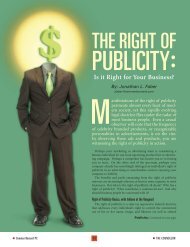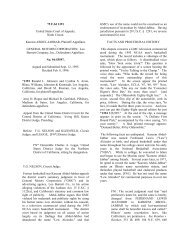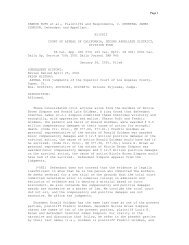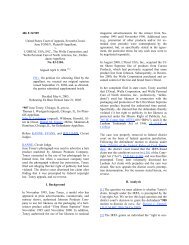Johnny Carson v. Here's Johnny Portable Toilets ... - Right Of Publicity
Johnny Carson v. Here's Johnny Portable Toilets ... - Right Of Publicity
Johnny Carson v. Here's Johnny Portable Toilets ... - Right Of Publicity
You also want an ePaper? Increase the reach of your titles
YUMPU automatically turns print PDFs into web optimized ePapers that Google loves.
extend only to a "name or likeness," and "<strong>Here's</strong><strong>Johnny</strong>" did not qualify.I.[1] Appellants' first claim alleges unfair competitionfrom appellee's business activities in violation of §43(a) of the Lanham Act, 15 U.S.C. § 1125(a)(1976), and of Michigan common law. The districtcourt correctly noted that the test for equitable reliefunder both § 43(a) and Michigan common law is the"likelihood of confusion" standard. Frisch'sRestaurants, Inc. v. Elby's Big Boy of Steubenville,Inc., 670 F.2d 642 (6th Cir.), cert. denied, 459 U.S.916, 103 S.Ct. 231, 74 L.Ed.2d 182 (1982); Wills v.Alpine Valley Ski Area, Inc., 369 Mich. 23, 118N.W.2d 954 (1963).[2] In Frisch's Restaurants we approved thebalancing of several factors in determining whether alikelihood of confusion exists among consumers ofgoods involved in a § 43(a) action. In that case weexamined eight factors:1. strength of the plaintiff's mark;2. relatedness of the goods;3. similarity of the marks;4. evidence of actual confusion;5. marketing channels used;6. likely degree of purchaser care;7. defendant's intent in selecting the mark;8. likelihood of expansion of the product lines.670 F.2d at 648. The district court applied asimilar analysis. Under the two-step processadopted in Frisch's Restaurants, these eightfoundational factors are factual and subject to aclearly erroneous standard of review, while theweighing of these findings on the ultimate issue ofthe likelihood of confusion is a question of law.670 F.2d at 651.[3][4] The district court first found that "<strong>Here's</strong><strong>Johnny</strong>" was not such a strong mark that its use forother goods should be *834 entirely foreclosed.498 F.Supp. at 74. Although the appellee hadintended to capitalize on the phrase popularized by<strong>Carson</strong>, the court concluded that appellee had notintended to deceive the public into believing<strong>Carson</strong> was connected with the product. Id. at 75.The court noted that there was little evidence ofactual confusion and no evidence that appellee'suse of the phrase had damaged appellants. Forthese reasons, the court determined that appellee'suse of the phrase "<strong>Here's</strong> <strong>Johnny</strong>" did not present alikelihood of confusion, mistake, or deception. Id.at 75-77.Our review of the record indicates that none of thedistrict court's findings is clearly erroneous.Moreover, on the basis of these findings, we agreewith the district court that the appellants havefailed to establish a likelihood of confusion. Thegeneral concept underlying the likelihood ofconfusion is that the public believe that "the mark'sowner sponsored or otherwise approved the use ofthe trademark." Warner Bros., Inc. v. Gay Toys,Inc., 658 F.2d 76, 79 (2d Cir.1981) (emphasisadded) (quoting Dallas Cowboys Cheerleaders,Inc. v. Pussycat Cinema, Ltd., 604 F.2d 200, 205(2d Cir.1979)).The facts as found by the district court do notimplicate such likelihood of confusion, and weaffirm the district court on this issue.II.The appellants also claim that the appellee's use ofthe phrase "<strong>Here's</strong> <strong>Johnny</strong>" violates the common lawright of privacy and right of publicity. [FN1] Theconfusion in this area of the law requires a briefanalysis of the relationship between these two rights.FN1. Michigan law, which governs theseclaims, has not yet clearly addressed theright of publicity. But the generalrecognition of the right, see W. Prosser,HANDBOOK OF THE LAW OF TORTS §117, at 805 (4th ed. 1971), suggests to usthat the Michigan courts would adopt theright. Michigan has recognized a right ofprivacy. Beaumont v. Brown, 401 Mich. 80,257 N.W.2d 522 (1977).[5] In an influential article, Dean Prosser delineatedfour distinct types of the right of privacy: (1)intrusion upon one's seclusion or solitude, (2) publicdisclosure of embarrassing private facts, (3) publicitywhich places one in a false light, and (4)appropriation of one's name or likeness for thedefendant's advantage. Prosser, Privacy, 48Calif.L.Rev. 383, 389 (1960). This fourth type hasbecome known as the "right of publicity." FactorsEtc., Inc. v. Pro Arts, Inc., 579 F.2d 215, 220 (2dCir.1978), cert. denied, 440 U.S. 908, 99 S.Ct. 1215,59 L.Ed.2d 455 (1979); see Zacchini v. Scripps-Howard Broadcasting Co., 433 U.S. 562, 572, 97S.Ct. 2849, 2855, 53 L.Ed.2d 965 (1977).Henceforth we will refer to Prosser's last, or fourth,category, as the "right of publicity."







